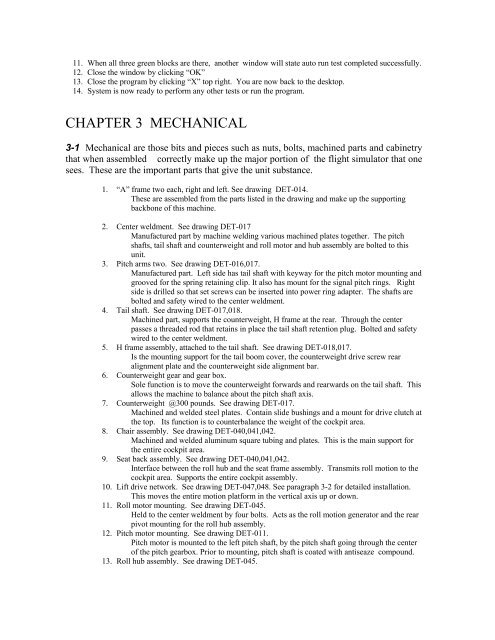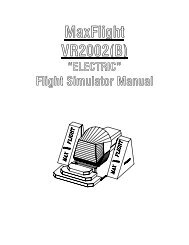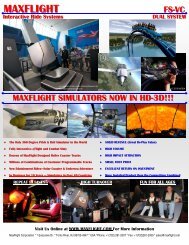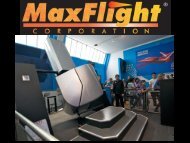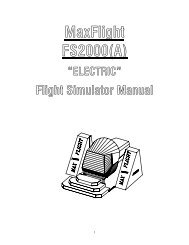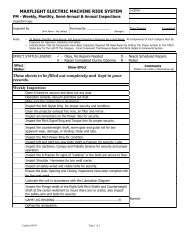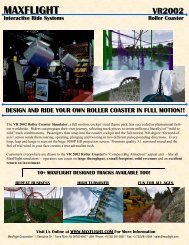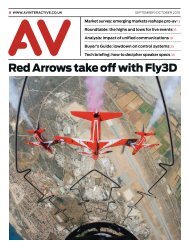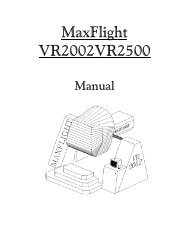MT3000 Complete - Electric - MaxFlight Corporation
MT3000 Complete - Electric - MaxFlight Corporation
MT3000 Complete - Electric - MaxFlight Corporation
Create successful ePaper yourself
Turn your PDF publications into a flip-book with our unique Google optimized e-Paper software.
11. When all three green blocks are there, another window will state auto run test completed successfully.<br />
12. Close the window by clicking “OK”<br />
13. Close the program by clicking “X” top right. You are now back to the desktop.<br />
14. System is now ready to perform any other tests or run the program.<br />
CHAPTER 3 MECHANICAL<br />
3-1 Mechanical are those bits and pieces such as nuts, bolts, machined parts and cabinetry<br />
that when assembled correctly make up the major portion of the flight simulator that one<br />
sees. These are the important parts that give the unit substance.<br />
1. “A” frame two each, right and left. See drawing DET-014.<br />
These are assembled from the parts listed in the drawing and make up the supporting<br />
backbone of this machine.<br />
2. Center weldment. See drawing DET-017<br />
Manufactured part by machine welding various machined plates together. The pitch<br />
shafts, tail shaft and counterweight and roll motor and hub assembly are bolted to this<br />
unit.<br />
3. Pitch arms two. See drawing DET-016,017.<br />
Manufactured part. Left side has tail shaft with keyway for the pitch motor mounting and<br />
grooved for the spring retaining clip. It also has mount for the signal pitch rings. Right<br />
side is drilled so that set screws can be inserted into power ring adapter. The shafts are<br />
bolted and safety wired to the center weldment.<br />
4. Tail shaft. See drawing DET-017,018.<br />
Machined part, supports the counterweight, H frame at the rear. Through the center<br />
passes a threaded rod that retains in place the tail shaft retention plug. Bolted and safety<br />
wired to the center weldment.<br />
5. H frame assembly, attached to the tail shaft. See drawing DET-018,017.<br />
Is the mounting support for the tail boom cover, the counterweight drive screw rear<br />
alignment plate and the counterweight side alignment bar.<br />
6. Counterweight gear and gear box.<br />
Sole function is to move the counterweight forwards and rearwards on the tail shaft. This<br />
allows the machine to balance about the pitch shaft axis.<br />
7. Counterweight @300 pounds. See drawing DET-017.<br />
Machined and welded steel plates. Contain slide bushings and a mount for drive clutch at<br />
the top. Its function is to counterbalance the weight of the cockpit area.<br />
8. Chair assembly. See drawing DET-040,041,042.<br />
Machined and welded aluminum square tubing and plates. This is the main support for<br />
the entire cockpit area.<br />
9. Seat back assembly. See drawing DET-040,041,042.<br />
Interface between the roll hub and the seat frame assembly. Transmits roll motion to the<br />
cockpit area. Supports the entire cockpit assembly.<br />
10. Lift drive network. See drawing DET-047,048. See paragraph 3-2 for detailed installation.<br />
This moves the entire motion platform in the vertical axis up or down.<br />
11. Roll motor mounting. See drawing DET-045.<br />
Held to the center weldment by four bolts. Acts as the roll motion generator and the rear<br />
pivot mounting for the roll hub assembly.<br />
12. Pitch motor mounting. See drawing DET-011.<br />
Pitch motor is mounted to the left pitch shaft, by the pitch shaft going through the center<br />
of the pitch gearbox. Prior to mounting, pitch shaft is coated with antiseaze compound.<br />
13. Roll hub assembly. See drawing DET-045.


